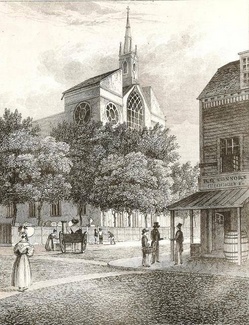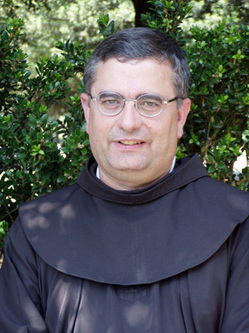Yesterday there was a story that caught my attention at the Catholic News Service (CNS) site: “Father’s suicide attempt leads Catholic family to help others.” The odd thing for me is that yesterday I put out in the parish vestibule a booklet on suicide (see below) thinking it might be helpful to some of the parishioners because the topic seems timely and since a young man accidentally committed suicide last year here.
Author: Paul Zalonski
My Lord and my God…
Saint Ephrem
Trinitarian love alone makes us happy
God does not live in splendid solitude… watch the rest here.
Gerard Manley Hopkins: 120th anniversary of death
Today is the 120th anniversary of death of Father Gerard Manley Hopkins, the Jesuit poet.
Peace
When will you ever, Peace, wild wooddove, shy wings shut,
Your round me roaming end, and under be my boughs?
When, when, Peace, will you, Peace? I’ll not play hypocrite
To own my heart: I yield you do come sometimes; but
That piecemeal peace is poor peace. What pure peace allows
Alarms of wars, the daunting wars, the death of it?
O surely, reaving Peace, my Lord should leave in lieu
Some good! And so he does leave Patience exquisite,
That plumes to Peace thereafter. And when Peace here does
house
He comes with work to do, he does not come to coo,
He comes to brood and sit.
Old Saint Patrick’s Cathedral to become a basilica?
 According a news article in today’s Daily News, Archbishop Dolan is petitioning the Holy See to name Old Saint Patrick’s Cathedral a minor basilica (the Wiki article as some other useful info). There are 2 basilicas in the Brooklyn Diocese but none in the Archdiocese. While it is largely an honorary distinction, it is seen as important and therefore prestigious. The old cathedral is quite a place as it continues to serve the spiritual needs of God’s people. For example, Holy Mass is celebrated in English, Spanish and Chinese each week.
According a news article in today’s Daily News, Archbishop Dolan is petitioning the Holy See to name Old Saint Patrick’s Cathedral a minor basilica (the Wiki article as some other useful info). There are 2 basilicas in the Brooklyn Diocese but none in the Archdiocese. While it is largely an honorary distinction, it is seen as important and therefore prestigious. The old cathedral is quite a place as it continues to serve the spiritual needs of God’s people. For example, Holy Mass is celebrated in English, Spanish and Chinese each week.
Solemnity of the Blessed Trinity
The Church professes her faith in the one God, who is at the
same time the Most Holy and ineffable Trinity of Persons: Father, Son and Holy
Spirit. The Church lives by this truth contained in the most ancient symbols of
faith. Paul VI recalled it in our times on the occasion of the 1900th
anniversary of the martyrdom of the holy Apostles Peter and Paul (1968), in the
symbol he presented which is universally known as the Credo of the People of
God.
Only “he who has wished to make himself known to us, and who
‘dwelling in light inaccessible’ (1 Timothy 6:16) is in himself above every
name, above every thing and above every created intellect…can give us right
and full knowledge of this reality by revealing himself as Father, Son and Holy
Spirit, in whose eternal life we are by grace called to share, here below in
the obscurity of faith and after death in eternal light.”
God is incomprehensible to us. He wished to reveal himself, not only as the one creator and Almighty Father, but also as Father, Son, and Holy Spirit. This revelation reveals in its essential source the truth about God, who is love: God is live in the interior life itself of the one divinity. This live is revealed as an ineffable communion of persons. This “mystery the most profound, the mystery of the intimate life of God himself” has been revealed to us by Jesus Christ: “He who is in the bosom of the Father, he has made him known” (John 1:18). The last words with which Christ concluded his earthly mission after the resurrection were addressed to the apostles, according to St. Matthew’s Gospel: “Go therefore and make disciples of all nations. Baptize them in the name of the Father and of the Son and of the Holy Spirit” (Matthew 28:119). These words began the Church’s mission and indicated her fundamental and constitutive task. The Church’s first task is to teach and baptize, to baptize means “to immerse” (therefore one baptizes with water) so that all may come to share God’s trinitarian life.
(Pope John Paul II, General Audience, October 9, 1985)
Saint Norbert of Xanten
O God, Who did raise up blessed Norbert, Thy Confessor and Bishop, to be an illustrious preacher of Thy word, and through him did render Thy Church fruitful with a new offspring; grant we beseech Thee, that helped by his merits we may practice by Thy grace what he taught both by word and deed.
2009 is the 875th anniversary of the death of Saint Norbert of Xanten, the founder of the 12th century Order of Premontre (the Norbertines).
The Pope, on behalf of the Church, wishes “to give thanks to the Lord for the many gifts He has bestowed through the extraordinary evangelical witness and exemplary zeal of your Holy Founder, the Holy Father hopes that this happy occasion will inspire a renewed fidelity to the model of the first Christian community gathered around the Eucharist and persevering in prayer with Mary, the mother of Jesus. May each monastery of the Order experience an increase in faithful dedication to the Church, austerity of life, missionary zeal, and the spirit of hospitality so that each monastery will become even more a house of prayer and a school of faith.”
Saint Boniface
With the Church we pray:
O God, Who by the zeal of blessed Boniface, Thy Martyr and Bishop, did vouchsafe to call a multitude of people to the knowledge of Thy Name; mercifully grant that we who celebrate his festival may also enjoy his protection.
From a Letter by Saint Boniface
In her voyage across the ocean of this world, the church is like a great ship being pounded by the waves of life’s different stresses. Our duty is not to abandon ship but to keep her on her course. The ancient Father showed us how we should carry out this duty: Clement, Cornelius and many others in the city of Rome, Cyprian at Carthage, Athanasius at Alexandria. They all lived under emperors who were pagans; they all steered Christ’s ship -or rather his most dear spouse, the church. This they did by teaching and defending her, by their labors and sufferings, even to the shedding of blood.
I am terrified when I think of all this. “Fear and trembling came upon me and the darkness” of my sins “almost covered me.” I would gladly give up the task of guiding the church which I have accepted if I could find such an action warranted by the example of the Father or by Holy Scripture. Since this is the case, and since the truth can be assaulted but never defeated or falsified, with our tired mind let us turn to the words of Solomon: “Trust in the Lord with all your heart and do not rely on your own prudence. Think on him in all your ways, and he will guide your steps.” In another place he says: “The name of the Lord is an impregnable tower. The just man seeks refuge in it and he will be saved.”
Let us stand fast in what is right and prepare our souls for trial. Let us wait upon God’s strengthening aid and say to him: “O Lord, you have been our refuge in all generations.” Let us trust in him who has placed this burden upon us. What we ourselves cannot bear let us bear with the help of Christ. For he is all-powerful and he tells us: “My yoke is easy and my burden is light.”
Let us continue to fight on the day of the Lord. “The days of anguish and of tribulation” have overtaken us; if God so wills, “let us die for the holy laws of our fathers,” so that we may deserve to obtain an eternal inheritance with them.
Let us be neither dogs that do not bark nor silent onlookers nor paid servants who run away before the wolf. Instead let us be careful shepherds watching over Christ’s flock. Let us preach the whole of God’s plan to the powerful and to the humble, to rich and to the poor, to people of every rank and age, as far as God gives us the strength, in season and out of season, as Saint Gregory writes in his Book of Pastoral Instruction.
Franciscans re-elect Friar Jose Rodriguez Carballo as 119th successor to Saint Francis
ASSISI, Italy (CNS) — Spanish Father Jose Rodriguez
Carballo was re-elected to head the Franciscan order during a general chapter
May 24-June 20 in Assisi, Italy, the birthplace of St. Francis. Father
Carballo, 55, was elected to a second six-year term as minister general of the
Order of Friars Minor June 4. Some 152 representatives of the order reconfirmed
the Spanish friar during the Assisi meeting as the leader of the 15,000
Franciscans who live in 113 countries. Father Carballo is the 119th successor of
St. Francis and will lead the Order of the Friars Minor until 2015. The
delegates will celebrate the 800th anniversary of the founding of their order
June 9. Father Carballo told reporters at the end of May that during the
general chapter the delegates were looking at how well the order has met the
priorities set in 2003 for deepening spirituality, improving fraternal life and
living as poor among the poor and in solidarity with all those in need. Second,
he said, they would try to find new ways to meet the challenge of being
missionaries in the modern world.







